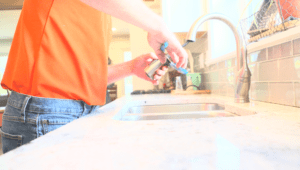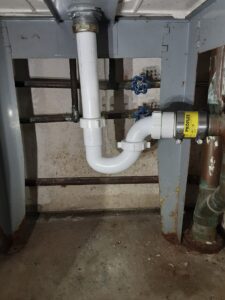
What’s worse than a sink full of dishes? How about a sink full of dirty dish water that is taking forever to drain! You’ve been here before in one room of your home or another. Sometimes it’s the kitchen sink or often it may be the bathroom sink when you’re trying to finish brushing your teeth. Water that is draining slowly from the sink is just a pain and a sign that you have some buildup in the drain. Let’s talk about the typical causes of the buildup, how to prevent them and how to remedy the problem before you run into a full-blown clog.
What are the most common causes of a slow draining sink?
Clogs from Products: Often the main cause of a backed-up sink is partial clogs from soap scum, toothpaste, hair buildup or cleaning products
Clogged Drain Stopper: All of the products mentioned above may have accumulated in your drain stopper rather than the pipe itself. This can also cause the sink to drain inefficiently. If that is the case, you can just remove the stopper and clean it to remedy the issue.
Dirty P-Trap: The P-Trap is the part of the pipe directly under your sink. This pipe has a bend in it and this is where clogs like to settle. This is the main reason for not pouring things like grease down your sink and they get stuck and solidify in this bend.
Corrosion: Over time your pipes can age and become corroded. The use of abrasive chemical cleaners can speed this process up causes your plumbing to fail faster. (Not sure what drain cleaners are safe for your sink? Check out our quick guide to at-home drain cleaners!)
How to fix a slow draining sink
Clean the Drain Stopper: If your sink that drains slowly is in the bathroom, you can try clearing out the drain stopper. As we mentioned, a lot of the products we use like toothpaste, hair gel and more can end up in the sink and stick to the stopper. Hair is also a leading cause of a clogged up drain stopper. Depending on the top of stopper you have, you may be able to remove it by hand. Some simply require a twist and will pop out. If you stopper won’t just twist off, then you may have to remove the horizontal rod under the sink. There should be a metal clip holding it in place. Remove this metal clip and also remove the pivot nut that attaches the rod to the sink drain. Then your drain stopper will lift out and you can clean it.
Use a Sink Plunger: You can purchase a sink plunger from any store like Lowe’s. They’re normally under $10. First, you will need to remove the stopper (as we went through in our previous scenario). Then add about enough water to the sink that the drain is covered by about an inch. From there, use the plunger the same way you would a toilet plunger. Simply place it over the sink drain and push down to create a seal. Pump the plunger a few times and then pull it off to see if the clog has cleared. Run some more water to test to see if your drain is now working properly.
DIY Drain Cleaner: There are many different options for DIY drain cleaners. Many call for a ½ cup of baking soda and a ½ cup of vinegar. Pour this down the drain and wait a few minutes. Here is a great list of DIY drain cleaners you can try at home. The benefit of these is that there are no harsh chemicals and made with items you typically already have at home.

Clean the P-Trap: This can sometimes be a bit further than most homeowners want to go to resolve their plumbing problem, but if you’re adventurous, here are some instructions to help! To do this you will need to disconnect the P-Trap, which is short for plumbing trap. This is the U-shaped pipe underneath the sink. Make sure water isn’t actively running in the sink first. You’ll also want to put a bucket underneath the P-Trap before you start. To remove the P-Trap, just unscrew the nut holding it in place on both sides. Normally this doesn’t require any tools unless it hasn’t been removed for a long time and is stuck. Any water present in the trap will spill out once it’s removed. Then you can get inside the trap to clean it. A wire brush is a handy tool to ensure the most efficient clean. When you replace the P-Trap just remember to run some water and test it to make sure it is not leaking.
Clean Pipe Debris: Use a drain cleaning tool; many are now using the Zip-it as a cheaper alternative to a drain auger. It is similar to a zip tie. You can stick it down the drain and then pull it back up to grab any hair or items that may be clogging up the pipe. We also still think the old school wire hanger could be used for this job as well.
Snake the Drain: You can purchase a drain auger at most hardware stores. Simply push the end of the snake into the drain and turn the handle to release more of the coil. Do this until you feel resistance. Continue to rotate the snake until you feel the resistance disappear, meaning that the blockage is gone. If the resistance doesn’t disappear, pull the snake back up and you may have the source of the clog attached to the end of the snake. Be sure to run water after removing the blockage to make sure you’ve gotten everything.
Need a plumber in Cincinnati?
If you’ve tried all the at-home fixes for your slow draining sink and it’s time to call a plumber, give Quality Comfort a call at 513-620-4822 or book plumbing service online 24/7.
